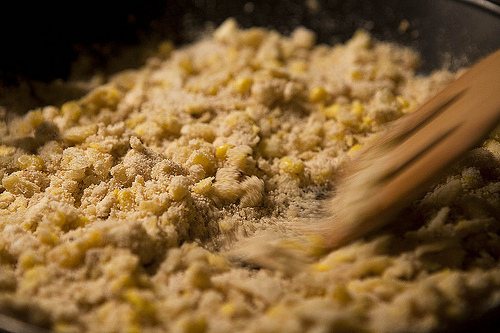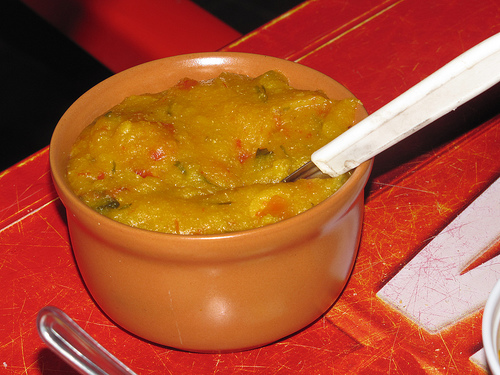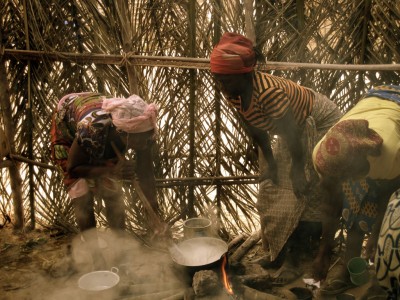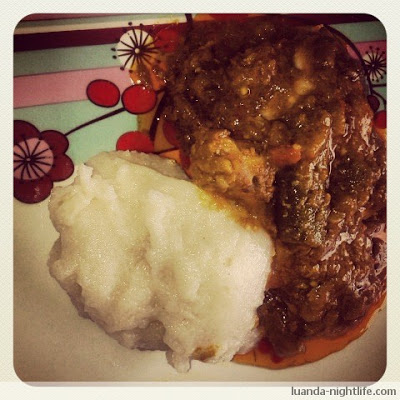[This post was written in collaboration with the Angolan author Cláudio Silva.]
The daily habits of Brazilians have inherited very little from the country's indigenous cultures. However, one indigenous foodstuff that has become a staple of Brazilian cuisine and has survived through the ages is cassava. This root vegetable comes in a number of varieties, and one of the most common by-products of cassava to be found in the Brazilian kitchen is cassava or manioca flour.
Brazilian food blog Sacola Brasileira (link is now broken) describes the popularity of cassava flour in Brazil:
Mas falou em mandioca, falou em farinha. Sabia que 80% da macaxeira cultivada no Brasil viram farinha? Pois é. Enquanto que o brasileiro consome 1 kg/ano do tubérculo, o consumo de farinha é de 3,7 kg/ano por pessoa (no norte do país, este número bate os 23,5 kg!). É por isso que cada região brasileira possui a sua própria farinha, com características que pertencem só àquele lugar, o que a tornam um marcador cultural importantíssimo….
So lets talk about cassava flour. Did you know that 80 percent of the cassava harvested in Brazil is used exclusively to make flour? It's true! Whilst Brazilians consume 1 kg of cassava per year, the consumption of cassava flour per person is 3.7 kg per year (in the north of Brazil this number can reach 23.5 kg!). As a result, each of the regions throughout Brazil have their own type of flour which is unique to them, meaning that cassava flour is an incredibly important cultural indicator….
Brazilian blog Comendo Bem [pt] explains how the flour is extracted from bitter cassava:
primeiro, as raízes são descascadas, lavadas e raladas. A massa ralada, depois de prensada para a extração da parte líquida, passa por um processo de esfarelamento ou descompactação para que possa ser peneirada. Por fim, a farinha é torrada e, depois de fria, é empacotada para a venda…..
First, the roots are peeled, washed and grated. After being pressed to extract the liquid, the grated roots are then pulverised so that they can then be sieved. Finally, the flour is toasted and when cooled, it is packaged ready to be sold…..
Farofa (toasted cassava flour)
When cassava flour is mixed with other basic ingredients such as eggs, water, butter or palm oil, it creates a very simple Brazilian dish which is usually served with fish, meat and pasta: farofa.
Brazilian blog Zona da Palavra [pt] suggests a recipe for the “perfect farofa”:
corte uma cebola em tirinhas fininhas
coloque duas colheres de sopa de manteiga numa panela quente
acrescente um fio de óleo calmamente
frite as cebolas até dourar como o pôr-do-sol do Jacaré
adicione 500 g de farinha de mandioca do sertão
de uma só vez
misture bem e
mantenha no fogo por mais 3 minutos redondostempere com sal da terra e pimenta-do-reinodeixe a farofa esfriar
em um refratário
aberto-o-o-o
por 1 hora exatabon appétit
fim da poesia
finely slice an onion
add one tablespoon of butter to a hot pan
add a dash of oil
fry the onions until they're as golden as the sunset on Jacare beach
add 500 g of cassava flour
give the mixture a good stir
cook for approximately three minutes and season with salt and ground black pepperleave the farofa to cool
in an o-o-o-pen dish
for exactly one hourbon appétit!
end of poetry
Pirão (cassava flour broth)
Depending on how much flour was added to the pan, you may end up with either farofa or pirão. Pirão is made using broth made from either fish stew or milk. Brazilian blog Analfabetos, Fracos, Pobres, Rudes e Santos [pt] explains how to make a good pirão:
Quem não gosta de pirão que me desculpe, mas não sabe o que é bom! Mas pra fazer um bom pirão, o peixe tem de estar fresquinho. E sobre o caldo em que foi cozido o peixe fresco vai se adicionando aos poucos a farinha torrada, sem deixar de realizar os movimentos constantes e circulares com a colher de pau, para não empelotar (ou embolotar, ou encaroçar). Não pode botar muita farinha pra não virar farofa. É só um pouquinho de farinha para engrossar o caldo, mantendo a consistência mole e apetitosa.
Anyone who dislikes pirão, well, I'm sorry, but there's something wrong with your taste buds! But to make a good Pirão, you have to use fresh fish. Gradually add the toasted flour to the broth in which the fish was cooked, stirring constantly with a wooden spoon to prevent it from becoming lumpy. Avoid adding too much flour otherwise you will get farofa. You only need a small amount to thicken the broth and retain the deliciously smooth consistency.
Beiju (tapioca)
Another delicacy which comes from cassava is beiju, also known as tapioca, depending on which region you find yourself in. It comes in the form of a pancake, rolled up and filled with cheese, meat, dulce de leche or guava. Differing from cassava flour, tapioca is a type of starch which is then seasoned with salt and cooked over a high heat until it takes the form of a pancake.
YouTube user Ivan Cordeiro filmed the staff at Tapioca do Irmão Firmino in Cajá, 100 kilometres from João Pessoa, the capital of Paraíba:
Funge (cassava paste)
And if the cassava had already reached Central America before the Portuguese had even crossed the Atlantic, it was the Europeans who brought cassava to Africa. Today, Nigeria is the largest producer of this root vegetable, and Angola has truly adopted cassava flour into their national cuisine, with funge de bombo (a dish made of cassava porridge) being a firm favourite.
Today, funge is so significant in Angola that not only is it the national dish of Angola, but it is also considered the most popular. Interestingly enough, few people remember that the cassava actually comes from Brazil and was introduced to Angola by Portuguese settlers.
For many years, eating funge on a Saturday with family has become part of Angola's culinary heritage, but for many of those less fortunate, funge is something that is eaten daily. Whilst northern Angola has a preference for funge de bombo made with cassava, the southern version contains maize and is yellow rather than a greyish colour.
However, by itself funge is flavourless – it is only as good as the sauce which accompanies it, and it is precisely these sauces which make Angolan cuisine stand out. Amongst the most popular sauces you will find Calulu, which is usually made with dried fish or fresh fish, okra, gimboa leaves (similar to spinach), onions, tomatoes and various other vegetables and also moamba de galinha (chicken stew), which is made using palm oil, tomatoes, onions, okra, aubergine and of course, chicken.
Verena Gois, owner of a food home delivery service in Luanda, shares with us a simple but tasty recipe for moamba de galinha with funge de bombó [pt]:
Ingredientes:
2 cebolas
3 tomates
900 gr de moamba
1 galinha
200 gr de beringela
200 gr de quiabos
Óleo de palma q.b.
Pique a cebola e o tomate e leve ao fogo, numa panela com um bocado de óleo de palma, para refogar durante uns minutos. Pique a beringela e adicione ao refogado com a moamba e a galinha cortada em pedaços pequenos. Adicione o sal a gosto. Deixe cozer, mexendo de vez em quando, durante 30 minutos mais ou menos, junte os quiabos cortados ao meio, prove o sal. Se necessário adicione um bocado de água. Deixe cozer mais 20 minutos ou ate a galinha estar macia e o molho apurado (grosso).
Ingredientes para o funge:
600gr de água
300 gr de fuba de bombo
Ponha a água ao fogo, quando começar a ferver, adicione a fuba aos bocados mexendo sem parar, com força, até obter uma massa lisa, se necessário adicione um bocado de água a ferver, e volte a bater. Serve-se com a moamba.
Ingredients:
2 onions
3 tomatoes
900 ml of chicken stock
1 chicken, finely diced
200 gr aubergine
200 gr okra, halved
palm oil to taste
Chop the onion and tomato and sauté in a pan with some palm oil for a few minutes. Chop the aubergine and add to the pan with the chicken. Season with salt to taste. Simmer for approximately 30 minutes, stirring occasionally, then add the okra and salt as required. If necessary add a drop of water. Leave to simmer for a further 20 minutes or until the chicken has softened and the sauce has thickened.
Ingredients for Funge:
600 ml water
300 gr polenta
Heat the water. When it reaches boiling point, gradually add the polenta, stirring constantly until it forms a smooth dough. Add more boiling water is necessary, and stir once again. Serve with stew.
[This post was written in collaboration with the Angolan author, Cláudio Silva]











2 comments
It substitutes the wheat. You can make bread, biscuits, pancakes and cakes with it.